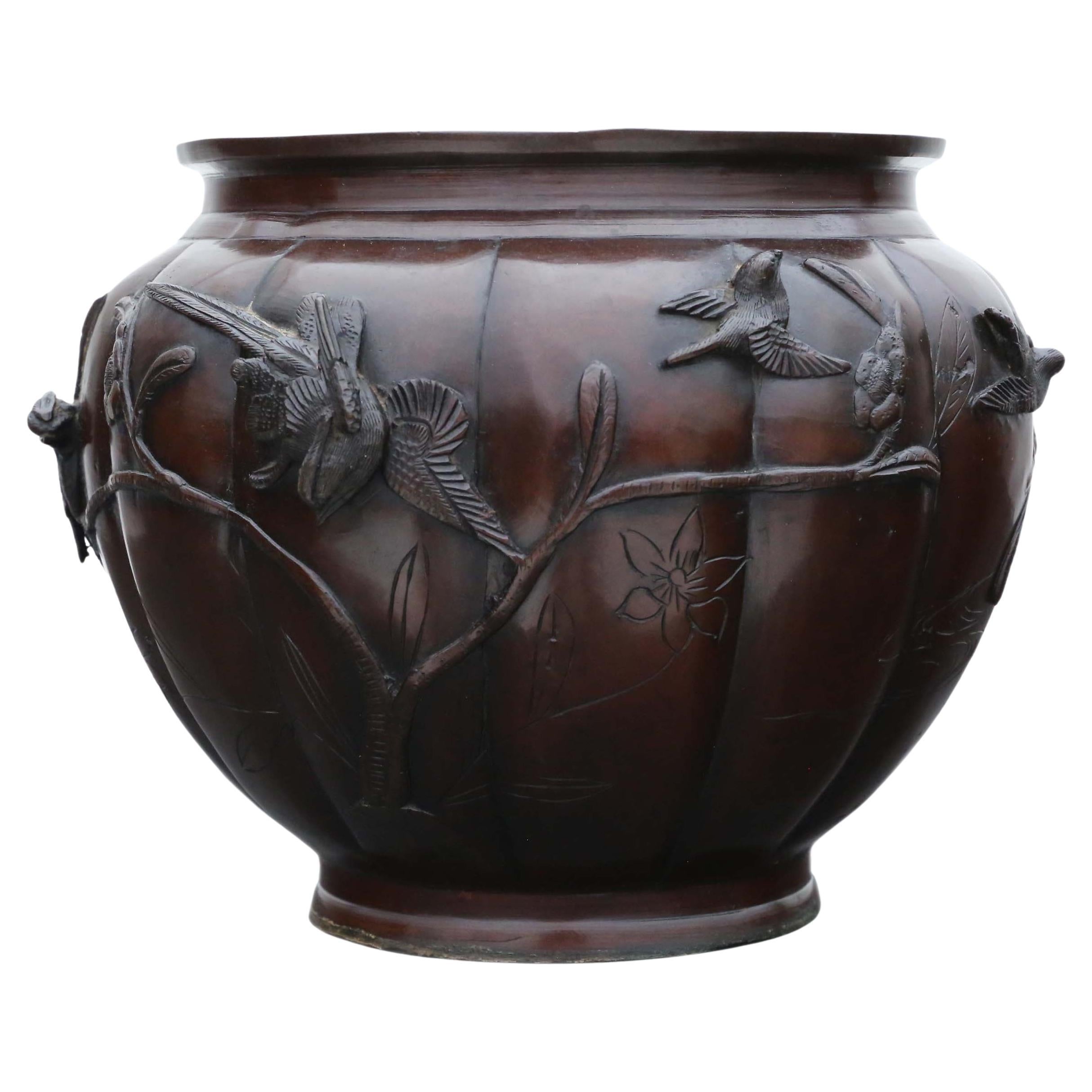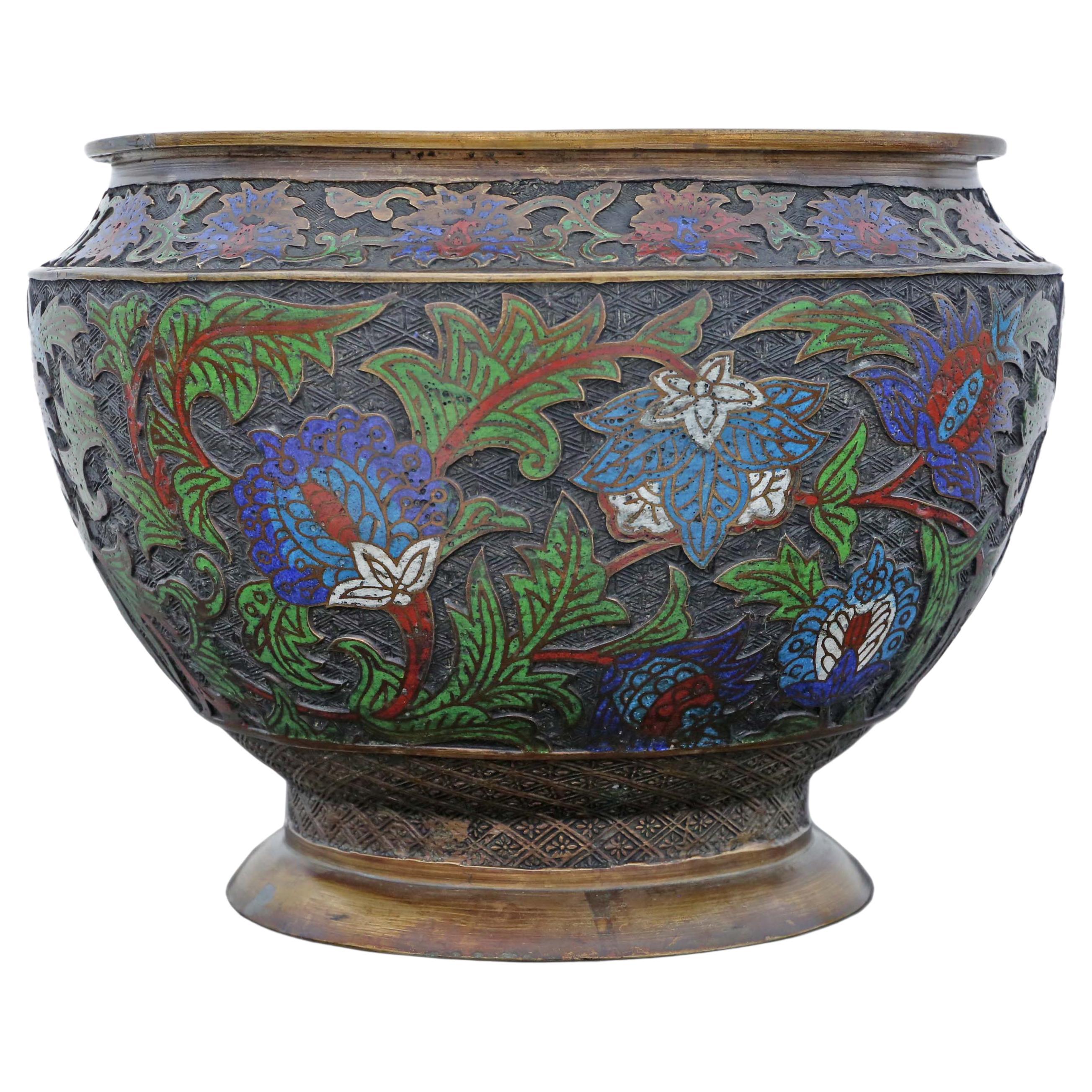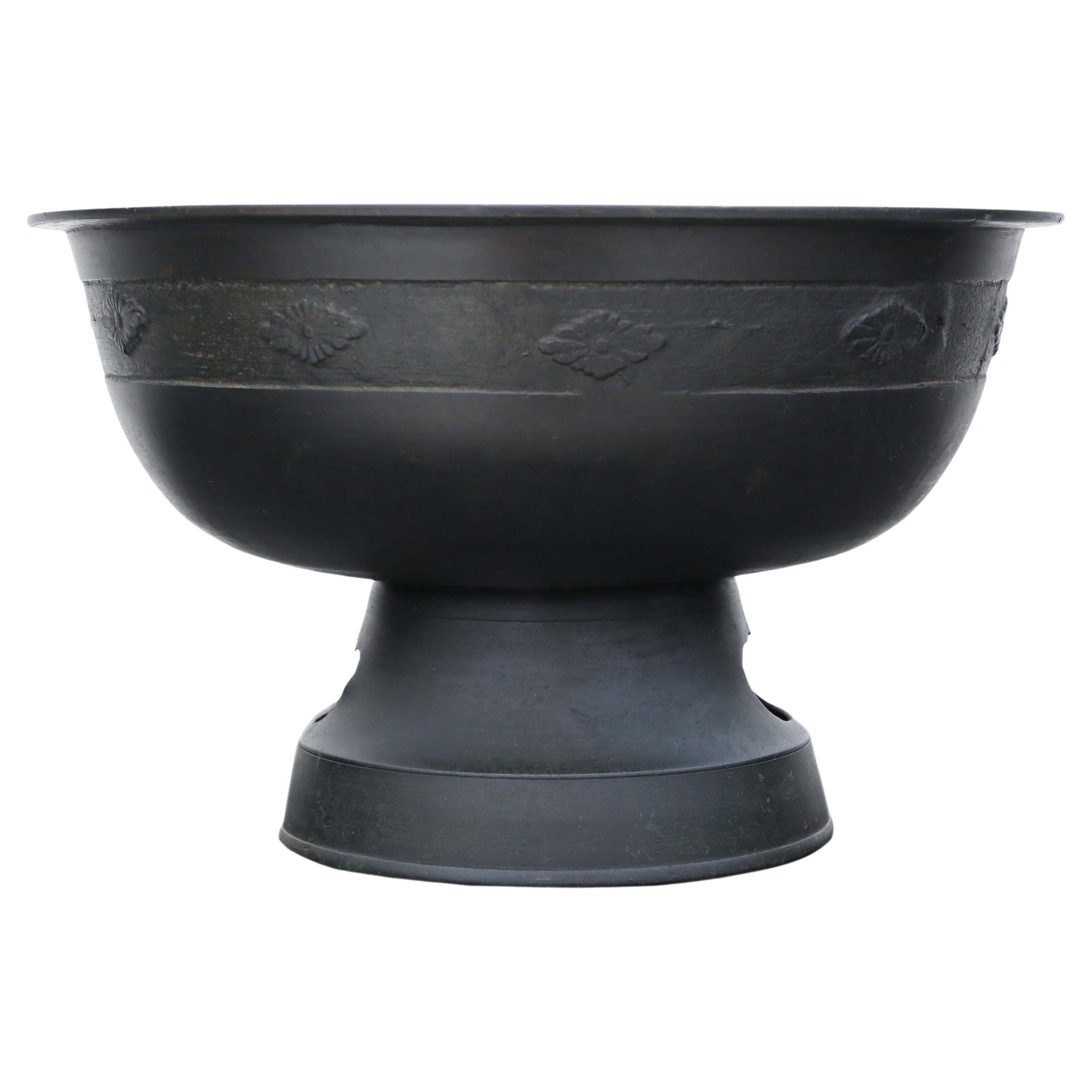Items Similar to Large Antique Asian Sculptural Iron Dragon Outdoor Planter Oriental Jardiniere
Want more images or videos?
Request additional images or videos from the seller
1 of 20
Large Antique Asian Sculptural Iron Dragon Outdoor Planter Oriental Jardiniere
About the Item
A large and most impressive antique Asian iron sculptural outdoor planter / jardiniere / garden ornament.
Styled after an ancient Chinese temple incense burner censer, monumental scale, whimsical Gothic Victorian taste, featuring highly detailed dragons wrapped around a pair of tall outswept handles, flanking a flaming pear over figural scence in relief, having a large single rectangular planter box, resting on ornate stand base with decorative elements, undulating scalloped apron, rising on sturdy cabriole legs adorned with stylized grotesque mask knees.
Beautifully aged patina over the whole adds to the unique antique character, warmth, and rich historical depth.
Dimensions: (approx)
34.5" High, 37 5" Wide, 18 5" Deep.
Distressed antique condition. Presents well. Heavily patinated, oxidized, worn, rustic and weathered, with various scattered losses, including loss to part of a dragon head. Heavy wear consistent with age and indicative of use. Possibly originally one piece, now two-piece, planting box and stand
- Dimensions:Height: 34.5 in (87.63 cm)Width: 37.5 in (95.25 cm)Depth: 18.5 in (46.99 cm)
- Style:Victorian (Of the Period)
- Materials and Techniques:Iron,Cast
- Place of Origin:
- Period:
- Date of Manufacture:1880
- Condition:Wear consistent with age and use. Minor losses. Minor structural damages. Minor fading. Good original condition. Presents well. Heavily patinated, oxidized, worn, rustic and weathered, with various scattered losses, including loss to part of a dragon head. Heavy wear consistent with age and indicative of use. Two-piece.
- Seller Location:Forney, TX
- Reference Number:1stDibs: LU5977229970182
About the Seller
4.8
Platinum Seller
These expertly vetted sellers are 1stDibs' most experienced sellers and are rated highest by our customers.
Established in 2013
1stDibs seller since 2021
200 sales on 1stDibs
Typical response time: <1 hour
- ShippingRetrieving quote...Ships From: Forney, TX
- Return PolicyA return for this item may be initiated within 7 days of delivery.
More From This SellerView All
- Antique Asian Carved Foo Dog Lion Architectural Corbels, a PairLocated in Forney, TXA magnificent pair of Qing Dynasty (1644-1912) antique Chinese architectural elements with beautifully aged patina. circa 1900 Most impressive large scale, likely sculptural corbels from a Buddhist temple or imperial palace, late 19th / early 20th century, each intricately hand carved with very fine detailing, similarly styled pair, modeled as guardian foo lion, depicted with outstretched arched body, mouth ajar, clutching floral ball, having elaborate openwork carvings, with scattered remnants of original polychrome paint remaining. The highly decorative architectural salvaged ornamental building elements presented on custom made hand carved wooden sculpture stands...Category
Early 20th Century Chinese Qing Architectural Elements
MaterialsWood, Paint
- Antique Italian Neoclassical Patinated Bronze Putti JardiniereLocated in Forney, TXA stylish and high-quality bronze neoclassical style sculpture in the form of a sophisticated standing winged putti (cherub-angel) holding a marble basin, dating to the early 20th century. This striking bronze features a finely detailed classic putti adorned in flowing narrow robe, standing atop an impressive and sumptuous tapering tripartite form sculptural stand, richly decorated with incised swirl accents, shell and grotesque mask medallions, rising on three shapely legs with high relief acanthus leaf decorated knees, ending in substantial sized whimsical paw and claw...Category
Early 20th Century Neoclassical Planters and Jardinieres
MaterialsMarble, Bronze
- Antique Clement Massier French Art Nouveau Majolica Griffin Jardiniere StandBy Clement MassierLocated in Forney, TXAn exceptionally executed antique, circa 1900, French majolica figural jardinière stand by Clement Massier (French, 1844-1917). Hand-crafted in Golfe-Juan, Southern France, around the turn of the late 19th / early 20th, period Art Nouveau styling, sculptural tripartite pedestal form in a visually striking mottled blue / brown drip glaze, featuring three griffin dragon supports rising on paw feet, accented by stylized foliage, resting on conforming triangular plinth base. Signed; 'Clement Massier Golfe Juan' embossed on base. Impressed mark at base. Used as a outdoor jardinière...Category
Early 20th Century French Art Nouveau Planters and Jardinieres
MaterialsMajolica
- 19th Century Italian Renaissance Revival Carved Jardiniere StandLocated in Forney, TXA magnificent antique, circa 1880, Italian Renaissance Revival style jardinière with warm, rustic beautifully aged patina! (plant stand - indoor planter - conservatory or solarium garden box - flower display) Born in Italy in the late 19th century, most likely originating in the Veneto region of Northern Italy (Venetian), exquisitely hand-crafted in medieval Italian Renaissance style / Henry II taste, having a removable metal interior liner with handles, resting in the well-made rectangular case with stepped molded edge, over paneled frieze adorned in intricate hand carved plaquette and foliate scrolled rinceaux relief ornamentation, rising on urn-form turned column supports, atop large platform shelf base with conforming stepped molded edge further raised on bun feet with primitive inset casters. Dimensions: (approx) 22" High, 40" Wide, 17.5" Deep A wonderful example of functional art. In good original antique condition, it's srong, sturdy and structurally sound with rich patina over the whole. Substantial wear consistent with age and indicative of use. Nothing that detracts from the aesthetics or functionality but only adds to the sophisticated character, European old world charm, elegant warmth and rich historical depth that can only be acquired over long periods of time. Presents well, retaining original antique character marks throughout. Distressed, worn, faded finish, with evidence of old water damages, age related splitting in the form of crack to one decorative panel, and scattered minor losses. Partial seized casters. Heavily oxidized patinated metal basin...Category
Antique 19th Century Italian Renaissance Revival Planters and Jardinieres
MaterialsMetal
- Mid-Century Paul Evans Brutalist American Modern Metal Planter BoxBy Paul EvansLocated in Forney, TXPaul Evans (1931-1987) American Brutalist industrial modern welded steel and copper, mixed metals patchwork and hardwood planter with rivet accents and removable metal insert. Can be used indoors or outdoors, with real plants or faux plants. Includes green styrofoam blocks for artificial plant use and natural stones for covering the top. Circa 1970 Dimensions: 26" High, 30" Wide, 11" Deep Please note, at the time of writing this, a matching coffee table is available separately. Please check our other listings or contact us to view it. Great original vintage condition. Strong, stable and structurally sound and in wonderful overall appearance; Age appropriate wear and tear, including minor scuffs, scattered scratches to wood panels and metal components. The black insert has fairly significant patinated weathered rustic oxidation consistent with age and indicative of use. The overall patina adds warmth and character to the overall aesthetic appeal and vintage authenticity. Biography: Paul Evans (American , 1927-1993) Born in Brooklyn, New York, Paul Evans is an American furniture designer and sculptor best known for his work in American Furniture design and the American craft movement. His work was influential to many furniture manufacturers in the second half of the 20th century, most notably Directional Furniture. He often used non-traditional materials and techniques like sculpted metal furniture. His work with Directional Furniture was extremely fruitful and during that time he started several series including their Argente, Sculpted Bronze, and Cityscape series. Evans started his career making copper chests and sculpted steel cabinets -- both of which are highly sought after today. Paul Evans’s work with Directional Furniture changed the relationship between creative directors and the companies they worked for. His name helped sell pieces, and he was consciously aware of that fact. As a proponent of modernism, Evans became an innovator in the furniture world. His patrons were often part of the New York elite, and he was able to enjoy sustained success, helped in large part by his ability to evolve with the times -- from craft-based in the 1950s to more flashy pieces in the 1970s and 1980s. His work was mostly recently featured at the Michener Art Museum and was the subject of a 2014 documentary. What kind of art does Paul Evans make? Paul Evans was primarily a furniture designer and sculptor. Though he started within the American Craft movement, Evans is hard to pin down stylistically. An expert metalworker and sculptor, several of Evans pieces were heavily influenced by the shipbuilding industry. As he moved through his career, his pieces became more stylistically diverse, but through it all there is a dedication to craft and function. Much of Evans work is best showcased in his work for Directional Furniture. He had several iconic lines including Patchwork Copper, Pewter and Brass, and the extremely popular CItyscape Series. In the 1980s, Evans branched off on his own with his Think Tank series. He opened his own showroom in New York City, but eventually retired in 1987. How did painter Paul Evans get started? Paul Evans was born on May 20th, 1931 in Newton, Pennsylvania. He studied sculpture and silversmithing at a number of colleges including the Philadelphia Textile Institute, the Rochester Institute of Technology, and the School for American Craftsmen. In the early 1950s, he attended the Cranbook Academy of Art in Michigan, later moving back to Pennsylvania to work with his mentor and guide, Phillip Loyd Powell. Together they began a business heavily influenced by the work of George Nakashima. Powell worked wood pieces, while Evans dedicated himself to metal. Evans burst onto the scene in the late 1960s and early 1970s as the American Craft movement exploded in popularity. From there he parlayed his popularity into a lucrative career with Directional Furniture. How much are Paul Evans pieces worth? Paul Evans furniture pieces can vary in value greatly, from a few thousand dollars on the low end to over $200,000 on the high end. In 2015 a Paul Evans wavy...Category
Mid-20th Century American Industrial Planters and Jardinieres
MaterialsMetal, Copper, Steel
- Alessandro Mazzucote Italian Art Nouveau Wrought Iron Pedestal Table Plant StandBy Alessandro MazzucotelliLocated in Forney, TXA spectacular, highly artistic, superb quality, forged iron jardinière planter / pedestal table attributed to celebrated master ironworker and decorator Alessandro Mazzucotelli (Italy, b.1865-d.1938) Featuring the distinctive spring-loaded tripartite base, far ahead of its time, sure to keep the piece solid, sturdy, and stable in any weather condition and even on uneven ground! Exceptionally executed, ornate, highly decorative Art Nouveau period styling, elaborately scrolled, gracefully curved shaped silhouette, stylized foliate accents, turned and spiral twisted wrought-iron, two tier, the upper fitted with a later bold, beautiful, dramatically veined round marble top, adding a touch of refined sophisticated elegance and the flexibility to bring indoors for use as a side table, plant stand, accent table, or simply displayed as sculptural patio furniture, truly functional art. Dimensions (approx): 38" High, 17" Wide, 17" Deep Provenance: Lonnie Alfred "Bo" Pilgrim (May 8, 1928 – July 21, 2017) was the co-founder of Pilgrim's Pride, which at one time was one of the largest chicken producers in the United States. Pilgrim co-founded Pilgrim's Pride when he opened a feed store...Category
Early 20th Century Italian Art Nouveau Patio and Garden Furniture
MaterialsIron
You May Also Like
- Antique Large Oriental Japanese Bronze Jardinière Planter Bowl MeijiLocated in Wisbech, CambridgeshireAntique large fine quality Oriental Japanese bronze Jardinière planter bowl censor Meiji Period 19th Century. Would look amazing in the right location and make a fabulous centre p...Category
Antique 19th Century Japanese Planters and Jardinieres
MaterialsBronze
- Antique Large Oriental Japanese Bronze Champleve Enamel Jardiniere Planter MeijiLocated in Wisbech, CambridgeshireAntique large quality Oriental Japanese bronze champleve enamel Jardiniere planter bowl C1910 Meiji Period. Would look amazing in the right location. Rare large size and design. ...Category
Vintage 1910s Japanese Planters and Jardinieres
MaterialsBronze
- Antique Large Oriental Japanese Chinese Bronze Champleve Enamel Jardiniere MeijiLocated in Wisbech, CambridgeshireAntique large quality Oriental Japanese chinese bronze champleve enamel Jardiniere planter bowl C1920. Would look amazing in the right location. Rare la...Category
Vintage 1920s Japanese Planters and Jardinieres
MaterialsBronze
- Japanese Bronze Jardinière Planter Bowl Pot- 19th Century Meiji Period, AntiqueLocated in Wisbech, CambridgeshireAntique Large Oriental Japanese Bronze Jardinière Planter Bowl Censor - Exquisite Meiji Period Piece! This stunning bronze jardinière planter bowl, originating from the 19th Century...Category
Antique 19th Century Japanese Planters and Jardinieres
MaterialsBronze
- Vintage Ebonized Square Chinoiserie Planter, Jardiniere or VaseLocated in Plainview, NYA stylish large square modernist shape planter or jardiniere adorned with gilt decoration on a dark ebonized background. Each panel is nicely hand painted with trees and plants motif...Category
Vintage 1980s Philippine Chinoiserie Planters and Jardinieres
MaterialsWood, Paint
- Antique Oriental Japanese Large Fine Quality Bronze Bowl Planter JardinièreLocated in Wisbech, CambridgeshireAntique Oriental Japanese large fine quality bronze Buddhist Tearai basin for water libation in a temple. Dates from the late Edo Period, mid 19th Century and is well suited for use ...Category
Antique Mid-19th Century Japanese Metalwork
MaterialsBronze
Recently Viewed
View AllMore Ways To Browse
Antique Oriental
Oriental Antique
Antique Dragons
Antique Dragon
Dragon Antique
Oriental Antiques
Antique Oriental Furniture Furniture
Antique Furniture Oriental
Antique Oriental Furniture
Oriental Antique Furniture
Oriental Box
Antique Oriental Stands
Pair Dragons
Iron Antique Legs
Antique Iron Legs Furniture
Iron Antique Furniture Legs
Outdoor Antiques
Large Decorative Planters





